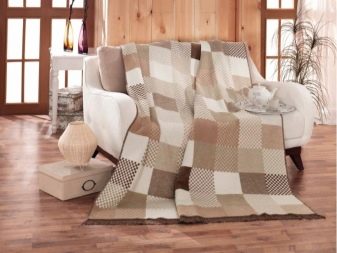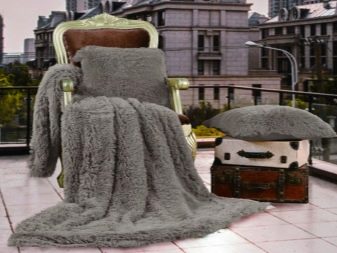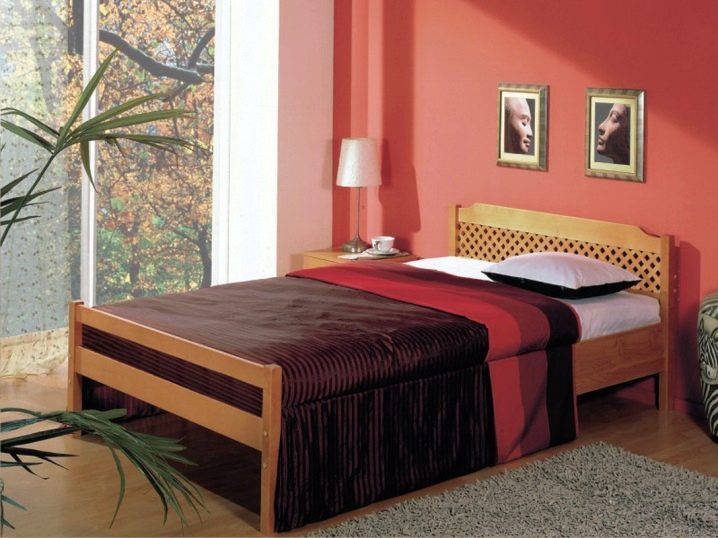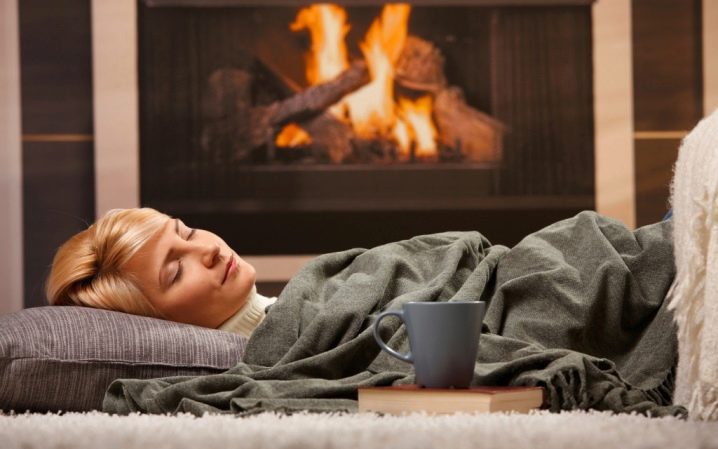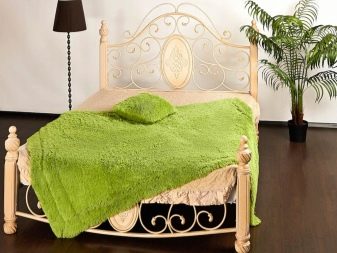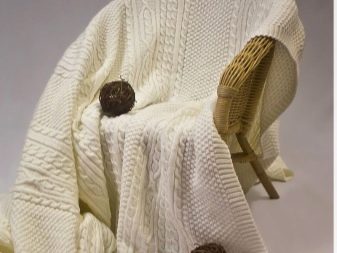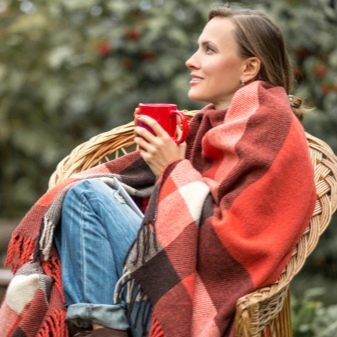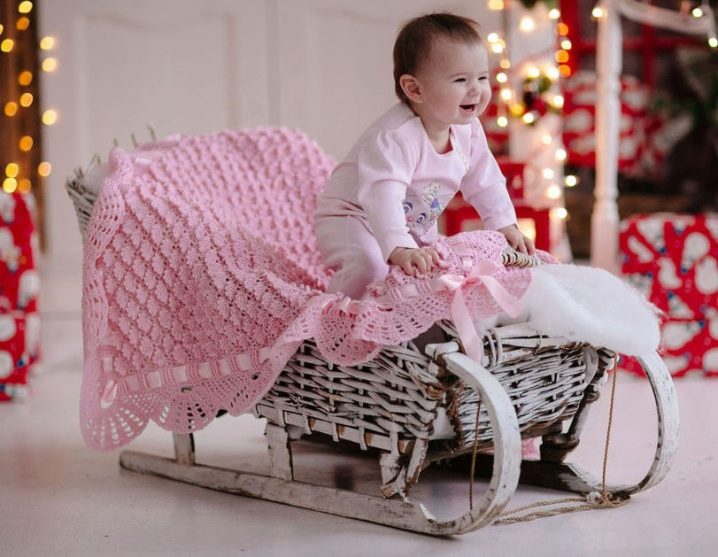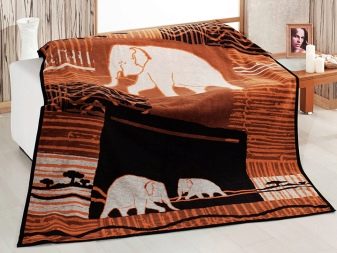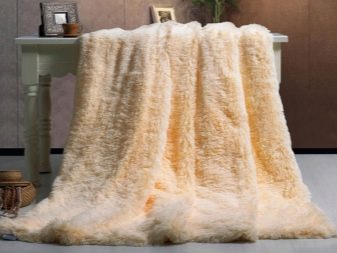Fluffy rugs
If you are annoyed, tired and cold, a soft, comfortable and cozy fluffy blanket will come to the rescue. On the features of his choice, the pros and cons of this product, the rules of care will tell our article.
Special features
That product, which we now call a rug, has changed its functions quite strongly during its existence. Now this cover on a sofa or blanket or a transforming cloak.
Therefore, when choosing and need to answer the question, what are you going to use it. The material, size, color preferences, length of pile will depend on it.
According to the material used plaids are:
|
natural |
artificial |
mixed |
|---|---|---|
|
wool |
faux fur |
natural with addition artificial additives or vice versa |
|
cotton |
microfiber |
|
|
fur |
polyester |
|
|
down |
acrylic |
|
|
silk |
fleece |
|
|
bamboo |
viscose |
Make them in the following way:
- sewing from a single cut fabric;
- patchwork;
- knitting (knitting);
- weaving.
In size divided into:
- children;
- teenage;
- adults.
In addition, blankets can be divided into the sphere of use. They can be called:
- homemade;
- road;
- blankets for outdoor recreation.
Kinds
Most often, natural bedspreads are used. woolen. They are non-staining, naturally self-cleaning with shaking, they absorb moisture well and retain heat. It has long been famous for its therapeutic effect in diseases of the spine and joints, as well as for colds. Wool products are durable.
But they can harm allergies. In addition, the real hair is spiny. For the skin it is useful, but unpleasant. Such things are painted in natural dull colors. Yes, and the high price may alienate some buyers.
- For the manufacture of high-quality bedspreads and blankets used merino wool - sheepgrown only in certain areas. Wool thread perfectly retains heat, repels odors and moisture. In sheep's wool there is creatine, which has an antibacterial effect.
- "Little Camel" - Alpac - gives wool 3 times lighter than merino wool. In addition, it is much less hypoallergenic due to the absence of lanolin in it. This means that both allergy sufferers and small children can use such blankets and blankets made of alpaca wool.
Ordinary camel's wool warms well and is more often used for making blankets. Such products are caustic. After each change of bed linen, they leave the villi in a duvet cover, which is not very convenient to use.
- Cashmere, created from the wool of a special breed of goats, is a cozy classic. Such plaids are very pleasant to the touch: soft, warm-giving, slightly fleecy.
The most expensive and elite cashmere is pashmina. Pure wool is very expensive, so modern manufacturers mix it with cotton and silk.
- The next type of natural materials are cotton (jacquard). They will not warm in the cold winter, but they will perfectly cover you in the off-season and in the warm season. Fur cloths - This is the luxury of palace castles and expensive interior. This is not a cheap pleasure, but it is a pleasure that will last you for many years.
- Feather bedspreads can be knitted from sheep, goat, camel and even dog yarns. They are eco-friendly, natural and very pleasant with tactile contact. They are easy to knit yourself of any size. But behind such a rug there will always be a train of villi.
- Silk luxury distinguishes beauty and lightness. It will be pleasant to touch the skin, it is great to let the air through, it will not be a source of allergy.
- Another natural material for manufacturing - bamboo. This material, unpretentious in leaving, will allow your body to breathe freely, will not allow it to overheat, will take away moisture in itself. Manufacturers make bamboo plaids smooth or textured.
- The most popular synthetic materials for sewing rugs - faux fur, microfiber, polyester, acrylic, fleece. The blanket from artificial fur is durable, soft, well passes air, but also well absorbs dust and is electrified. Microfiber - modern material, which is made of polyamide and polyester. Because of the thin thread, the fabric weighs little.
This material is very convenient to use, but does not like high temperatures, so it does not allow ironing and drying near high-temperature heaters.
- Polyester - This is a fabric of polyester fibers. It is easy to wash, does not require ironing, dries quickly, weighs little, tactilely pleasant, does not absorb odors, durable, inexpensive. At the same time electrified and deformed from high temperatures. Acrylic canvas durable, lightweight, hypoallergenic. It is easy to care for him. It does not attract dust to itself, but at the same time it does not “breathe”. Refers to the most democratic price offer.
- Fleece blanket - a find for household and travel. It is more expensive than acrylic, but it is worth it.
Fleece is like wool, but it is suitable for allergies. It absorbs moisture and allows the body to breathe. It warms well and is very pleasant to the touch.
- Viscose made from cellulose (plant matter), so of all artificial materials, it is the most environmentally friendly. According to the properties resembles fleece. The minus of these tissues is fragility, since with constant use the thing quickly loses its beauty.
It is to improve the quality of the fabric and mix different materials. Such mixtures allow you to borrow the advantages of synthetics and natural fibers.
When you add an artificial thread in natural, the fabric becomes stronger and more durable. The combination of acrylic with wool withstands more washings and becomes softer.Polyester in combination with cotton makes the fabric stronger. Under such a blanket is warmer, it will not shrink after washing.
So, we figured out what are the rugs on the material used. Now let's answer the question of how they are made.
Artificial plaids are usually made from a single piece of fabric. They can be single or double sided, single or double layered. The edges of such a product can be hemmed or trimmed with tape.
Ragged Plaid - this is almost a design job. It can be made independently from pieces of fabric of different textures and colors. It will be a beautiful bedspread in a room decorated in a rustic style. But it can be abstractionism or geometry. Here, the main thing is to choose the color range.
Things created using knitting needles or a hook look very nice. Wool knitted with acrylic - warm, breathable, more durable compared to pure wool items. Such a blanket can be knitted with one cloth, but it can also be knitted. Separate parts are then stitched or knitted among themselves with the help of knitting needles or a hook.Of particular popularity are the things of large mating, they can be linked independently or purchased in stores and workshops.
The duvet is knitted in a usual knitted fashion with or without a pattern.
After mating the thing you need to wash and dry in the unfolded form on the absorbent fabric. To keep the product smooth, you can gently stretch it with safety pins.
Woven bedspreads are already difficult to make at home due to the lack of machine tools. But in workshops or in production, plaids can be woven from wool, rags of various qualities (according to the principle of rugs in Russian villages) and other materials.
Colors
Before you buy, you need to think carefully about what colors should be plaid, so as not to disturb the harmony of the house. The palette will help you to choose the right colors. It will always be appropriate to look classic: fabric is lighter than furniture on a few tones.
- If there are lilac flowers on the purple walls of the room, then the blanket can be lilac with small purple petals.
- All shades of beige, milk, coffee with milk, brown, pastel yellow, coffee, champagne will make the room warm and cozy, and the blanket in green, light green will soothe and protect.
- Pink, peach, turquoise color is suitable for the room of the girl undergrowth or young girl.
- For the sensation of coolness use blue and blue.
- Olive and light green would be appropriate to look like in a two-color rug, and in combination with similar colors of the room decor.
- In the room, decorated in style loft, a reddish black-coated bedspread would be a good addition to brick walls.
- A gray plush blanket will be harmonious with metal and glass style high tech.
- White, like black, can play the role of a background. For example, a red and burgundy cage in white or black framing is a classic Scottish plaid.
- Coloring "dark leopard" is quite rich and attracts attention. It can be used where the walls and furniture are plain.
Dimensions
Do not forget to choose the right size. It will depend on the destination: a cape for a chair, a blanket for a sofa or bed (for children or adults), a blanket.
- For newborns, they use blankets 75x75 cm, 75x90 cm; 100x120 cm, for small children - 110x140 cm; 130x160 cm, 140x205 cm will be suitable for children of 7-12 years old.
- As a cape on the chair using the size of 130x170 cm.
- Road blanket - 140x200 cm.
- A cover of 170x200 cm will fit on the bed of a teenager.
- On a standard queen-size bed it is better to take a blanket of at least 180x220 cm.
- For a large bed and a sofa, choose a model of euro 220x240 cm.
- For non-standard beds and large (corner) sofas, a canvas of 240x260 cm is suitable.
When choosing, remember that the blanket should completely cover the bed or sofa, hanging from the sides, but not touching the floor. If the blanket is used as a blanket, then it should be chosen to fit the size of the bed and duvet cover.
Popular manufacturers and reviews of their products
Manufacturers of blankets in the world very much.
- Of the Russian manufacturers is to provide Ivanovo masters (including company Marianna), offering a huge selection of textiles: plaids are smooth and shaggy, “weed” 1-3 cm high or cloth with high pile. Customer reviews for this product are very good.
- Another Russian company is Mona Liza. Specializes in artificial fibers. Especially popular are their plaids of acrylic. As the buyers write, the declared price corresponds to the quality.
- Domestic firm Cleo pleased buyers with bamboo blankets and earned rave reviews: bamboo microfiber is not electrified, does not crunch, it is soft, light and warm.In addition, customers like the packaging of this product.
- Pantex – Russian brandproducing cotton blankets. The company also creates "fluffy", for which cotton is combined with acrylic. Let out classical models, road, elite. There is a large selection of children's blankets and bedspreads, which are very appreciated by customers for their high quality.
- For kids Russian company "Sleepy Gnome" developed a line of products from mixed materials. Young mothers take to their babies, for example, a “Droplet” blanket, whose lining is made from 100% cotton, and the front side is 100% polyester. According to moms, these plaids are soft, pleasant, but have uninteresting faded patterns.
- Arloni Company represents the environmental products of India. In the product line there are natural cotton blankets handmade. This is not the cheapest brand, but its things are beautiful, hypoallergenic, and practical, as customers note in their reviews.
- Buenas noches (formerly Domomaniya) is a Chinese company producing a wide range of textiles. Blankets of this manufacturer are distinguished by bright realistic patterns. Even after a large number of washings, the colors retain their brightness.Buyers who left their reviews, pay attention to the high price of the goods. At the same time threads sticking out of the seams of the rug, which had to be removed independently.
- Incalpaca – This is Peruvian natural rugs from alpaca and merino wool. Such blankets, by definition, cannot be cheap, but are in great demand for their curative and ecological properties. Buyers note that rugs prick a little, but still call them soft and pleasant to the body.
- Portuguese rugs Luxberry - it is high quality and high price. Classic knitted and woven wool blankets attract buyers no less than artificial fabrics.
- German company Biederlack manufactures products from light cotton and warm sheep wool, delicate cashmere and acrylic, polyacryl and durable polyester. Buyers call a distinctive feature a design, a diverse color palette, which, even after a large number of washes, retains its appearance.
- Among Turkish companies worth noting Arya. The combination of European quality and oriental flavor is what distinguishes this brand. It produces rugs made of faux fur with a large pile, polyester, coarse calico, fleece, microfiber. Things are beautifully painted.
- Campaign attracts attention Sleepy. This manufacturer keeps up with the times and releases blankets transformers with two and four sleeves (for two). Such things from microplus pleasantly warm in cold weather.
But buyers recommend that manufacturers attach the instructions for using a plush blanket, as when buying it turned out that the thing is too fleecy and frayed.
Tips for choosing and operating
To favorite thing served as long as possible, you must carefully care for her:
- To plush blankets or microfiber blankets are not poured, they need to wash before using. This should be done with every new thing, regardless of the fabric. But before washing, be sure to read the information on the label.
- Cotton items can be washed in a washing machine, but without spinning, so that they keep their shape. After the water has drained, lay the blanket on the floor or on a wire rack to speed drying.
- Wash fluffy rugs made of synthetic materials in the delicate wash mode. In this case, the brightness of the colors will last for a long time, and the product will not change its geometry. Before washing, remove all rubbish from the pile: mote, thread, crumbs.
- The high-nap blanket is erased separately from other items.To keep the “fluffy”, roll it in with a nap.
- For washing it is preferable to use liquid detergents. Choose the synthetic mode. Plaid with a long nap is better not to squeeze in the drum: after rinsing you will have to carefully remove the blanket and let it flow over the bath.
- Products made of wool are washed only by hand at a temperature of 30 degrees. Carefully prostrate the thing without pulling it out or twisting it. Lightly squeeze.
- Synthetic fabric can be dried on a conventional clothesline. Blankets made of natural fibers are dried on a horizontal surface, preferably on a grid, so that the fabric dries with natural ventilation and does not acquire a musty smell. Textiles should not be exposed to direct sunlight. To restore the softness and fluffiness of the blanket, it is necessary to comb it after drying with a comb with short sparse teeth.
- Between washes, regularly shake out dust and debris from the rug, if necessary, clean the product with a clothes brush.
But the time will come when the bright blanket from use and washings will turn gray. How to bleach a light blanket? It depends on the material.
- Grayed synthetic can be bleached with industrial detergents without chlorine.
- When bleaching with salt, soak the thing in a salt solution at the rate of 600 g of salt per 10 liters of water. Then rinse and wash with detergent.
- Dissolve 10 tablespoons of soda and 2 tablespoons of 3% ammonia in 10 liters of warm water and soak the blanket for at least 3 hours, then wash the product with powder.
- If you rub salt and chalk into a greasy stain, you can restore the whiteness to an artificial rug. Brush the mixture after a few hours.
- A patch of ink-stained tissue should be soaked and washed in fresh milk or yogurt.
- Wrap lemon in cheesecloth, apply it to the rust stain and press it with an iron.
To whiten woolen blankets, you can use the following tips:
- Use special liquid powders that are intended for washing wool.
- Pound about 1 kg of chalk in water and immerse there a smooth rug. Hold the item in the solution, constantly turning it over, for about an hour. Rinse thoroughly. For fleecy things, this method is not suitable.
- You can also use the above recipes with salt, soda and ammonia.
How to store blankets?
If the composition of the product is natural fibers, then it should be stored in a cardboard box, but not in polyethylene.Synthetic products are less demanding for storage, but they will be electrified from packages.
Choosing a blanket, follow the simple rules:
- dark colors reduce space, while light ones increase;
- bright colors will distract from massive furniture;
- a warm or dense textile in the interior will suit a woolen or fleece blanket;
- light curtains will be combined with smooth and thin products;
- The bright design of the room does not match the floral pattern of the plaid.
How to choose the right blanket and how to take care of it - in the next video.
Of course, the blanket you will buy to complete the image of your room. This is not the main design element, but it can highlight the beauty and comfort of your home or eliminate all your efforts.
Fluffy rugs in the interior
In the children's room, the blanket can be used as a bedspread on a bed or sofa, as a blanket. A rug with a long nap can serve as a rug for the child. In the living room you will be helped by a set of capes for chairs and a rug for a sofa. But do not forget to take care of the fabric texture. Shaggy plaid "fluffy" will be out of place in a classic room with furniture upholstered in silk.
A fleece blanket on the bed in the bedroom will look at home comfortable, and smooth - elegant. Scottish blanket - the very place in the country. It is useful for evening gatherings on the veranda. It will be pleasant to wrap up in it, sitting by the fireplace or rustic stove.





















